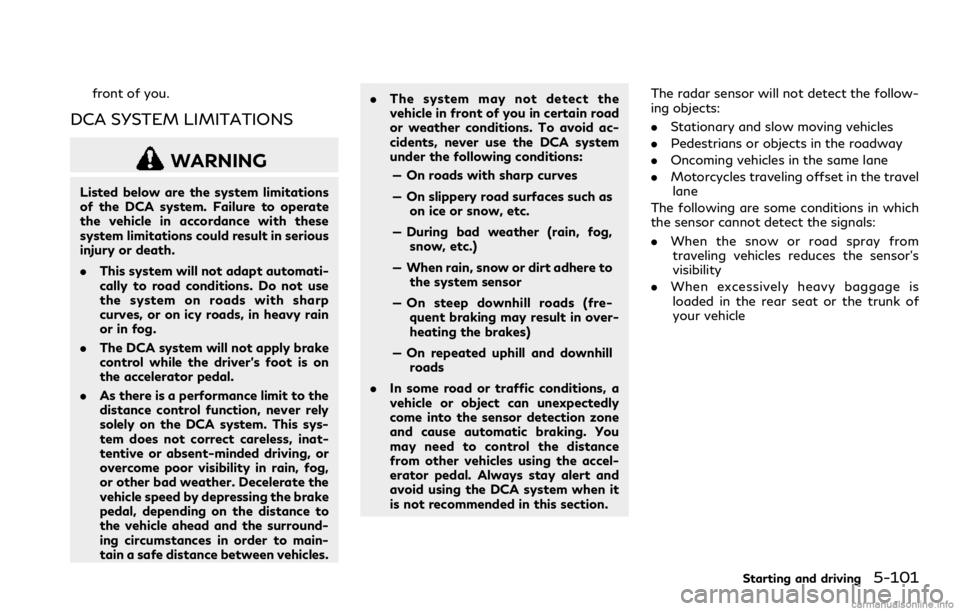2018 INFINITI Q60 COUPE brake sensor
[x] Cancel search: brake sensorPage 264 of 466

— On roads where the traffic is
heavy or there are sharp curves
— On slippery road surfaces such as
on ice or snow, etc.
— During bad weather (rain, fog,
snow, etc.)
— When rain, snow or dirt adhere to
the system sensor
— On steep downhill roads (the
vehicle may go beyond the set
vehicle speed and frequent brak-
ing may result in overheating the
brakes)
— On repeated uphill and downhill
roads
— When traffic conditions make it
difficult to keep a proper distance
between vehicles because of fre-
quent acceleration or deceleration
.In some road or traffic conditions, a
vehicle or object can unexpectedly
come into the sensor detection zone
and cause automatic braking. You
may need to control the distance
from other vehicles using the accel-
erator pedal. Always stay alert and
avoid using the ICC system when it is
not recommended in this section.The radar sensor will not detect the follow-
ing objects:
.Stationary and slow moving vehicles
.Pedestrians or objects in the roadway
.Oncoming vehicles in the same lane
.Motorcycles traveling offset in the travel
lane
The sensor generally detects the signals
returned from the vehicle ahead. Therefore,
if the sensor cannot detect the reflection
from the vehicle ahead, the ICC system may
not maintain the selected distance.
The following are some conditions in which
the sensor cannot detect the signals:
.When the snow or road spray from
traveling vehicles reduces the sensor’s
visibility
.When excessively heavy baggage is
loaded in the rear seat or the trunk of
your vehicle
The ICC system is designed to automatically
check the sensor’s operation within the
limitation of the system. When the sensor
is covered with dirt or is obstructed, the
system will automatically be canceled. If the
sensor is covered with ice, a transparent or
translucent vinyl bag, etc., the ICC system
may not detect them. In these instances, the
vehicle-to-vehicle distance control mode
may not cancel and may not be able to
maintain the selected following distancefrom the vehicle ahead. Be sure to check
and clean the sensor regularly.
Starting and driving5-85
Page 274 of 466

JVS0869X
The DCA system is intended to assist the
driver in keeping a following distance from
the vehicle ahead traveling in the same lane
and direction.
If the radar sensor
detects a slower
moving vehicle ahead, the system will reduce
the vehicle speed to help assist the driver to
maintain a following distance.
The system automatically controls the throt-
tle and applies the brakes (up to approxi-
mately 40% of vehicle braking power) if
necessary.
The detection range of the sensor is approxi-
mately 650 ft (200 m) ahead.
JVS0844X
Dynamic driver assistance switch
Driver assist system forward indicator
(green) (on the vehicle information dis-
play)
Vehicle ahead detection indicator (on
the vehicle information display)
Lower display
Starting and driving5-95
Page 277 of 466

5-98Starting and driving
Approach warning
If your vehicle comes closer to the vehicle
ahead due to rapid deceleration of that
vehicle or if another vehicle cuts in, the
system warns the driver with the chime and
DCA system display. Decelerate by depres-
sing the brake pedal to maintain a safe
vehicle distance if:
.The chime sounds.
.The vehicle ahead detection indicator
blinks.
.The driver assist system forward indica-
tor (orange) blinks.
The warning chime may not sound in some
cases when there is a short distance be-
tween vehicles. Some examples are:
.When the vehicles are traveling at the
same speed and the distance between
vehicles is not changing
.When the vehicle ahead is traveling
faster and the distance between vehicles
is increasing
.When a vehicle cuts in near your vehicle
The driver assist system forward indicator
(orange) blinks and the warning chime will
not sound when your vehicle approaches
vehicles that are parked or moving slowly.NOTE:
The approach warning chime may sound
and the driver assist system forward in-
dicator (orange) may blink when the radar
sensor detects objects on the side of the
vehicle or on the side of the road. This may
cause the DCA system to decelerate or
accelerate the vehicle. The radar sensor
may detect these objects when the vehicle
is driven on winding roads, narrow roads,
hilly roads or when entering or exiting a
curve. In these cases you will have to
manually control the proper distance ahead
of your vehicle.
Also, the sensor sensitivity can be affected
by vehicle operation (steering maneuver or
driving position in the lane) or traffic or
vehicle condition (for example, if a vehicle is
being driven with some damage).
Page 280 of 466

front of you.
DCA SYSTEM LIMITATIONS
WARNING
Listed below are the system limitations
of the DCA system. Failure to operate
the vehicle in accordance with these
system limitations could result in serious
injury or death.
.This system will not adapt automati-
cally to road conditions. Do not use
the system on roads with sharp
curves, or on icy roads, in heavy rain
or in fog.
.The DCA system will not apply brake
control while the driver’s foot is on
the accelerator pedal.
.As there is a performance limit to the
distance control function, never rely
solely on the DCA system. This sys-
tem does not correct careless, inat-
tentive or absent-minded driving, or
overcome poor visibility in rain, fog,
or other bad weather. Decelerate the
vehicle speed by depressing the brake
pedal, depending on the distance to
the vehicle ahead and the surround-
ing circumstances in order to main-
tain a safe distance between vehicles..The system may not detect the
vehicle in front of you in certain road
or weather conditions. To avoid ac-
cidents, never use the DCA system
under the following conditions:
— On roads with sharp curves
— On slippery road surfaces such as
on ice or snow, etc.
— During bad weather (rain, fog,
snow, etc.)
— When rain, snow or dirt adhere to
the system sensor
— On steep downhill roads (fre-
quent braking may result in over-
heating the brakes)
— On repeated uphill and downhill
roads
.In some road or traffic conditions, a
vehicle or object can unexpectedly
come into the sensor detection zone
and cause automatic braking. You
may need to control the distance
from other vehicles using the accel-
erator pedal. Always stay alert and
avoid using the DCA system when it
is not recommended in this section.The radar sensor will not detect the follow-
ing objects:
.Stationary and slow moving vehicles
.Pedestrians or objects in the roadway
.Oncoming vehicles in the same lane
.Motorcycles traveling offset in the travel
lane
The following are some conditions in which
the sensor cannot detect the signals:
.When the snow or road spray from
traveling vehicles reduces the sensor’s
visibility
.When excessively heavy baggage is
loaded in the rear seat or the trunk of
your vehicle
Starting and driving5-101
Page 313 of 466

5-134Starting and driving
wheel from locking, the system helps the
driver maintain steering control and helps to
minimize swerving and spinning on slippery
surfaces.
Using the system
Depress the brake pedal and hold it down.
Depress the brake pedal with firm steady
pressure, but do not pump the brakes. The
ABS will operate to prevent the wheels from
locking up. Steer the vehicle to avoid
obstacles.
WARNING
Do not pump the brake pedal. Doing so
may result in increased stopping dis-
tances.
Self-test feature
The ABS includes electronic sensors, electric
pumps, hydraulic solenoids and a computer.
The computer has a built-in diagnostic
feature that tests the system each time you
start the engine and move the vehicle at a
low speed in forward or reverse. When the
self-test occurs, you may hear a “clunk”
noise and/or feel a pulsation in the brake
pedal. This is normal and does not indicate a
malfunction. If the computer senses a mal-function, it switches the ABS off and
illuminates the ABS warning light on the
instrument panel. The brake system then
operates normally, but without anti-lock
assistance.
If the ABS warning light illuminates during
the self-test or while driving, have the
vehicle checked. It is recommended you visit
an INFINITI retailer for this service.
Normal operation
The ABS operates at speeds above 3 to 6
MPH (5 to 10 km/h).
When the ABS senses that one or more
wheels are close to locking up, the actuator
rapidly applies and releases hydraulic pres-
sure. This action is similar to pumping the
brakes very quickly. You may feel a pulsation
in the brake pedal and hear a noise from
under the hood or feel a vibration from the
actuator when it is operating. This is normal
and indicates that the ABS is operating
properly. However, the pulsation may indi-
cate that road conditions are hazardous and
extra care is required while driving.The Vehicle Dynamic Control (VDC) system
uses various sensors to monitor driver inputs
and vehicle motion. Under certain driving
conditions, the VDC system helps to perform
the following functions.
.Controls brake pressure to reduce wheel
slip on one slipping drive wheel so power
is transferred to a non slipping drive
wheel on the same axle.
.Controls brake pressure and engine out-
put to reduce drive wheel slip based on
vehicle speed (traction control function).
.Controls brake pressure at individual
wheels and engine output to help the
driver maintain control of the vehicle in
the following conditions:
— understeer (vehicle tends to not follow
the steered path despite increased
steering input)
— oversteer (vehicle tends to spin due to
certain road or driving conditions).
The VDC system can help the driver to
maintain control of the vehicle, but it cannot
prevent loss of vehicle control in all driving
situations.
When the VDC system operates, the VDC
warning light
in the instrument panel
flashes so note the following:
.The road may be slippery or the system
may determine some action is required to
help keep the vehicle on the steered path.
VEHICLE DYNAMIC CONTROL
(VDC) SYSTEM
Page 456 of 466

M
Maintenance
Battery .............................................................. 8-16
General maintenance ...................................... 9-2
Indicators for maintenance (vehicle
information display) ...................................... 2-27
Inside the vehicle ............................................. 9-3
Maintenance log ............................................ 9-17
Maintenance precautions .............................. 8-3
Maintenance requirements ........................... 9-2
Maintenance schedules ................................. 9-6
Maintenance under severe
driving conditions .......................................... 9-16
Outside the vehicle ......................................... 9-2
Seat belt maintenance ................................. 1-17
Standard maintenance .................................... 9-7
Under the hood and vehicle ......................... 9-4
Malfunction indicator light (MIL) .................... 2-19
Map lights .............................................................. 2-56
Master warning light .......................................... 2-16
Mechanical key (Intelligent Key system) .......... 3-3
Memory storage
Automatic drive positioner ......................... 3-32
Meter
Trip computer ................................................. 2-29
Meters and gauges ................................................ 2-6
Instrument brightness control ................... 2-43
Mirror
Inside mirror .................................................... 3-29
Outside mirrors ............................................. 3-30Vanity mirror ................................................... 3-32
Moonroof ............................................................... 2-54N
NAVI Shift Control .............................................. 5-20
New vehicle break-in ........................................ 5-124
O
Odometer .................................................................. 2-7
Off-road recovery .................................................. 5-9
Oil
Capacities and
recommended fluids/lubricants ................. 10-2
Changing engine oil and filter .................... 8-11
Checking engine oil level ............................. 8-11
Engine oil ........................................................ 8-10
One touch unlock sensor (See Intelligent
Key system) .............................................................. 3-9
Operation
Indicators for operation ............................... 2-23
Outside air temperature .................................... 2-31
Outside mirrors .................................................... 3-30
Overheat, If your vehicle overheats ............... 6-21
Owner’s Manual/Service Manual
order information ............................................. 10-25
P
Panic alarm ............................................................ 3-17Parking
Parking brake operation .............................. 5-21
Parking on hills ............................................ 5-128
Parking brake break-in .................................... 5-132
PERSONAL mode ............................................... 5-25
Phone
Car phone or CB radio ................................... 4-3
Power
Power door lock ............................................... 3-4
Power outlet ................................................... 2-47
Power steering fluid ..................................... 8-14
Power steering system .............................. 5-129
Power windows ............................................. 2-52
Power moonroof ................................................. 2-55
Power steering warning light ........................... 2-16
Precautions
Braking precautions .................................... 5-132
Child restraints ............................................... 1-19
Cruise control ................................................. 5-71
Maintenance ..................................................... 8-3
Seat belt usage ............................................... 1-11
Supplemental restraint system .................. 1-38
When starting and driving ............................ 5-4
Pre-crash seat belts with
comfort function ................................................... 1-13
Predictive Forward Collision
Warning (PFCW) ............................................... 5-115
Push starting ......................................................... 6-21
Push-button ignition switch .............................. 5-11
11-5